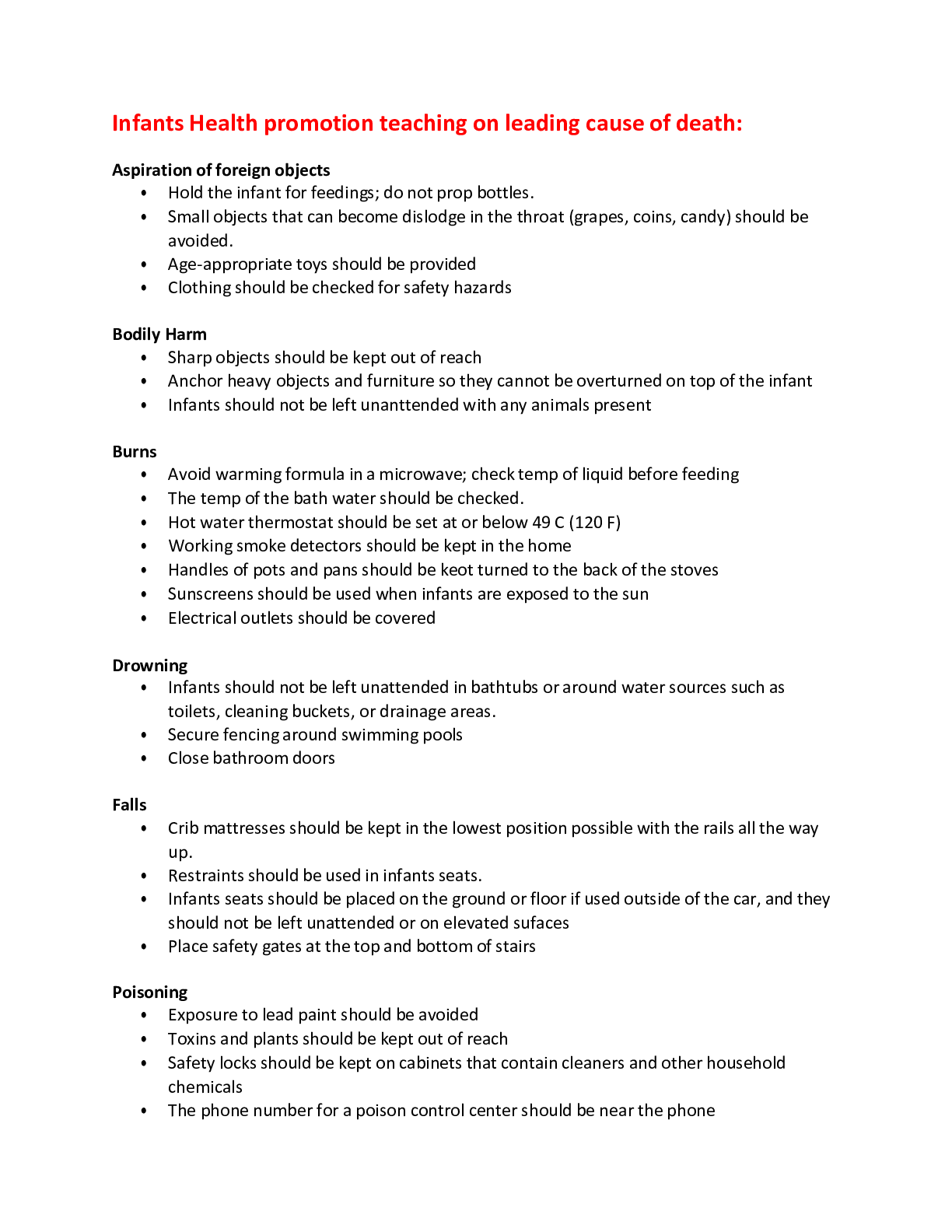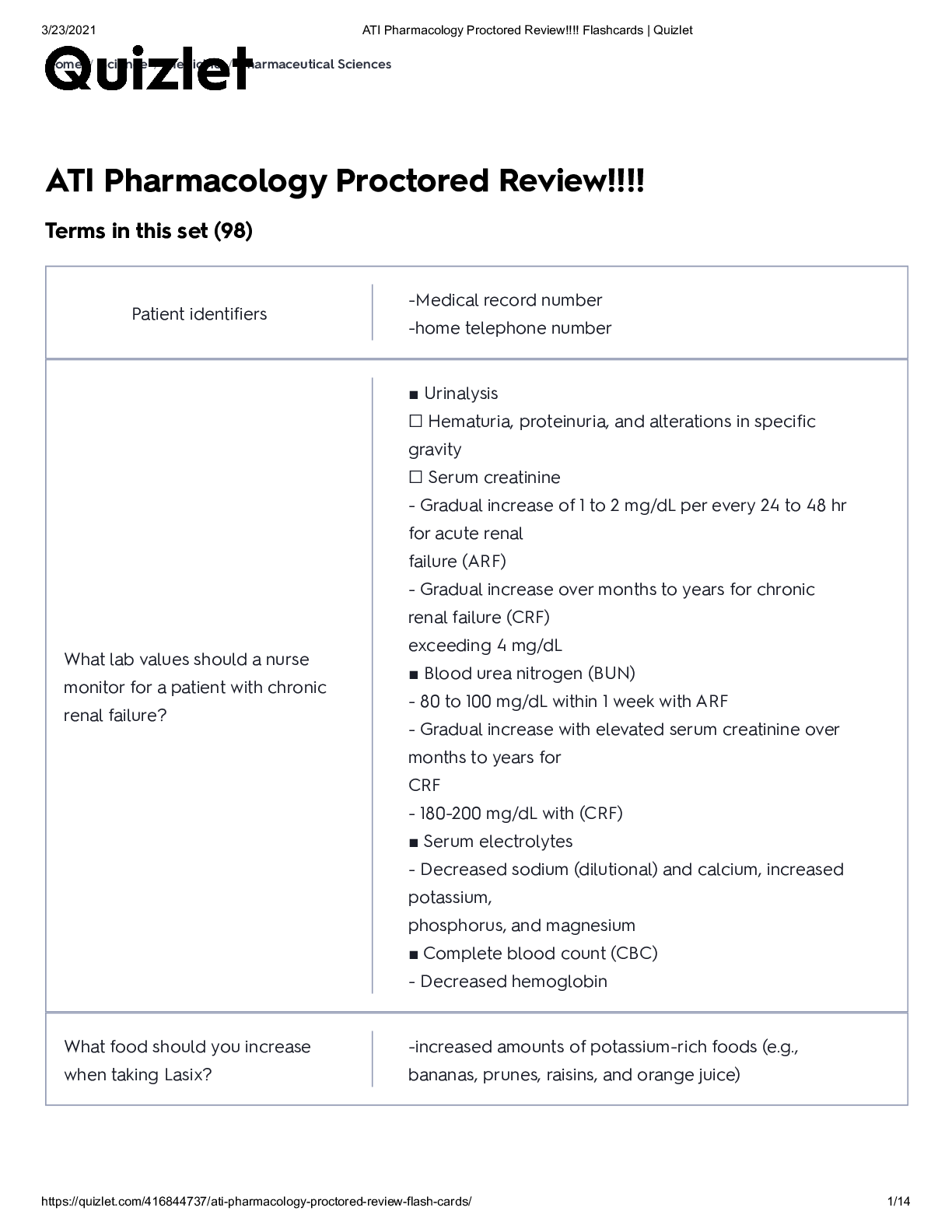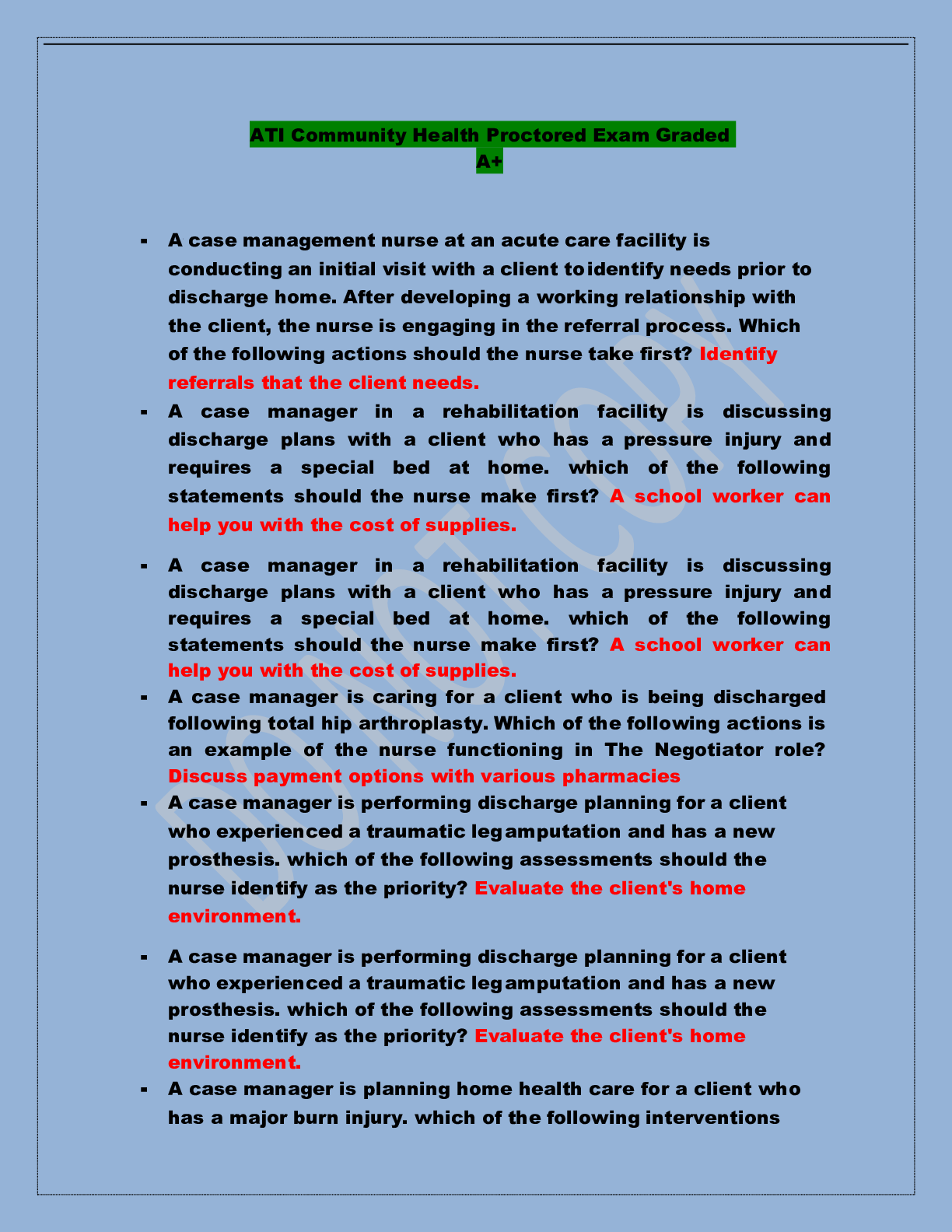*NURSING > EXAM REVIEW > ATI MENTAL HEALTH PROCTORED EXAM FOCUSED REVIEW (All)
ATI MENTAL HEALTH PROCTORED EXAM FOCUSED REVIEW
Document Content and Description Below
LOC • Alert: responsive, answer questions appropriately, opens eyes spontaneously. • Lethargic: open their eyes, can answer questions but easily falls asleep. • Stupor: barely responds to p... ainful stimuli (like rubbing the patients’ sternum) • Comatose: unconscious/does not respond to painful stimuli • Decorticate: flexion/ internal rotation of upper extremities, joints and legs • Decerebrate: neck/elbows extension, wrist and finger flexion Torts: unintentional torts- negligence: forgetting to set the bed alarm for a patient who is at risk for falling and falls out of bed. Malpractice- giving the wrong medication to the patient, error that harms the patient. Intentional torts: Assault vs Battery: • Assault is if you threaten someone, “If you do not take this pill, I will smack you.” • Battery: when you actually hurt someone, “You actually act by smacking the patient.” • False imprisonment: Nurse will purposely restrain the patient or give them a chemical to a pt. for the nurse convenience, instead of doing alternatives techniques. Six Ethical Principles • Beneficence – Doing good by the patient, what is best for the patient. Making the patient feel safe in the environment that their in. • Autonomy- respecting their rights by what they decide for their health care. Clients making decisions but the patient must accept consequences of those decisions. • *Veracity- truthfulness “Being honest with the patient’s treatment” • Justice- fair/equal rights for everyone. • *Fidelity- being loyal to the patient, keeping promises. • Non-maleficence: Doing No Harm Legal Rights of the patients in Mental Health • Pt has the right to refuse treatment even if they’re in a mental health facility. • Pts confidentiality: HIPPA: cannot be released without the consent of the patient • If someone calls the unit asking about the patient refer them to contact the patient’s family regarding the patient well being • Over hear a conversation in a public place: tell them to go have the conversation in a private setting. • Mandated that abuse is reported, with a child or an older adult. • Our duty to warn third parties if they’re at risk for harm. Informed Consent: Provider: • Communicate the purpose of the procedure • Give a clear description of the procedure in the patient primary language. • Explain the risks vs the benefits • Other options in treating the condition RN Role: • make sure the provider gives this information to the patient. • Pt is competent in receiving the information, they must be an adult or an emancipated child, THERE CAN BE NO IMPAIRMENTS! • If they do not understand the information then we do not answer the questions, have the provider answer the questions. Restraints: • Physical- vest, belt, and mittens. LAST RESORT • Chemical- sedative/antipsychotic medications • Alternatives before restraints: verbal interventions, calm/quiet environment, diversions. • Prescriptions must be written • Write an order for restraints to be placed on patient. If the orders need to be renewed it has to be renewed within 24 hours. • Care for the Patient: • Assessing the patient vital signs q 15 mins • Offer them food and fluid- Every hour • Make sure they get the chance to toilet- Every hour • Monitor vital signs. Emergency Restraints Placed: • get an order from the doctor within 15-30 mins • Time limits: 18 and older: 4 hours, 9-17: 2 hours, 8 and under= 1-hour, extra documentation: event that caused the restraints to be placed, alternative interventions that were attempted, time treatment began, med administered, patient assessment including current behavior, v/s, pain. Pts care provided: food, helping them to the bathroom. Therapeutic Communication: • *Always try to get more information from the patient. You never want to shut down communication between you and the patient. *“Always go for tell me more response” • Intrapersonal communication: self-talk, thinking thoughts, not verbalizing them. • Interpersonal communication: one on one communication with another person. • Open ended questions: promote interactive discussions “Tell me more, can you share more about x y,z • Closed ended= when looking for a specific answer/ Medical History. Yes/no answers Clarifying techniques: Restating = repeating back the patient exact words Reflecting= returning focus back to the patient Paraphrasing = restating the patients’ feelings and thoughts to confirm what has been communicated. “What I think I hear you saying is this” Exploring= gathering more information about something that the patient has mentioned. “You mentioned this can you tell me little more about that.” General leads= allows the patient to guide the discussion *Presenting reality= focus on what is actually happening to stop the hallucination, delusions, faulty beliefs. “Must be really scary to hear voices can you tell me what their saying” Offering self: demonstrates a willingness to spend time, and the nurse has a genuine concern. Barriers: • Do not offer personal opinions: Never say “ You should do this” • Do not give advice • Do not give false reassurance. • *NEVER ASK WHY! • Never offer value judgements • Don’t do excessive questioning. • Respond approvingly or disapprovingly • Always stay neutral while talking. “ I know exactly how you feel” Never say this! Best Practices when working with older adults: Minimize distractions, discuss health in a private setting, face the patient when speaking, use a low-pitched voice, in the beginning of the interview identify the concerns/needs of the patient, limit the number of items on the questionnaire,* give the patient plenty of time to respond to questions when gathering data* Defense Mechanisms: • *Repression: putting unacceptable ideas out of unconscious awareness. “ Pushing it out of your mind and not thinking about it actively. • Displacement: Substituting a different target, Ex: A person who loses his job at work but comes home and destroys his son favorite toy. • *Disassociation: temporarily blocking memories from conscious thought. “Going through a sexual assault, forgetting who they are, having an out of body experience” • *Projection: projecting your thoughts on someone else. “Other people are having your feeling” • Denial: Not happening, pretending the truth is not reality to manage anxiety. • Rationalization: creating an excuse or unacceptable reason for someone’s behavior. “I had to do this .to do this thing” • Altruism: dealing with anxiety but reaching out to others, if their experiencing a loss or anxiety cope by reaching out to others. • Sublimination: “Substitute” negative impulses into an acceptable form of expression. “Really angry go to the gym and work out really hard” • Suppression: voluntarily denying unpleasant thoughts/feelings. “Putting it in the back of your mind and not wanting to think about it” • Regression=reverting back to child like behaviors that do not go with the adult developmental stage. “When a new baby enters the family, the older child decides to not utilize the bathroom even though they have already been toilet trained.” • Reaction: overcompensating/demonstrating the opposite behavior of what is felt. “I love nursing exams; I love select all that apply questions” • Undoing= performing an act, to make up for prior behavior “Husband hits wife, then brings home flowers to make up for that behavior” • Compensation= emphazing strengths to make up for weakness. “disabled person is compensating by being great at academics” • Identification= adopting one’s ideas from a group or individual • Intellectualization=Separating emotions/feelings from logical facts to help with coping. • Conversion= responding to stress through unconscious development of physical symptoms not caused by physical illness “A person experiences deafness after his partner tells him he wants a divorce. • ***Splitting = in ability to recognize positive/negative attributes of others or self “All or nothing mentality” .....................................................................................................................................................................................................CONTINUED [Show More]
Last updated: 1 year ago
Preview 1 out of 23 pages
Instant download
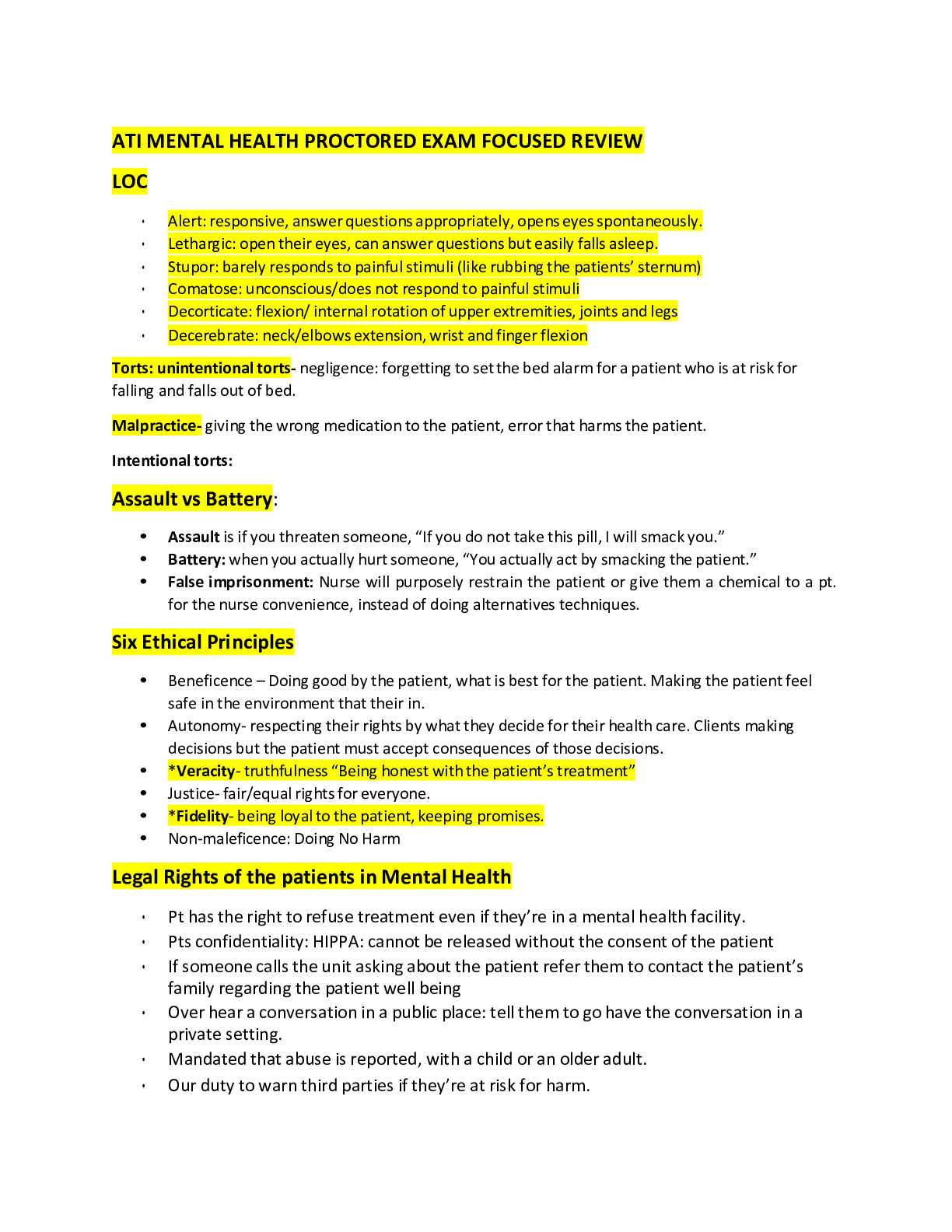
Buy this document to get the full access instantly
Instant Download Access after purchase
Add to cartInstant download
Reviews( 0 )
Document information
Connected school, study & course
About the document
Uploaded On
Nov 20, 2021
Number of pages
23
Written in
Additional information
This document has been written for:
Uploaded
Nov 20, 2021
Downloads
0
Views
205

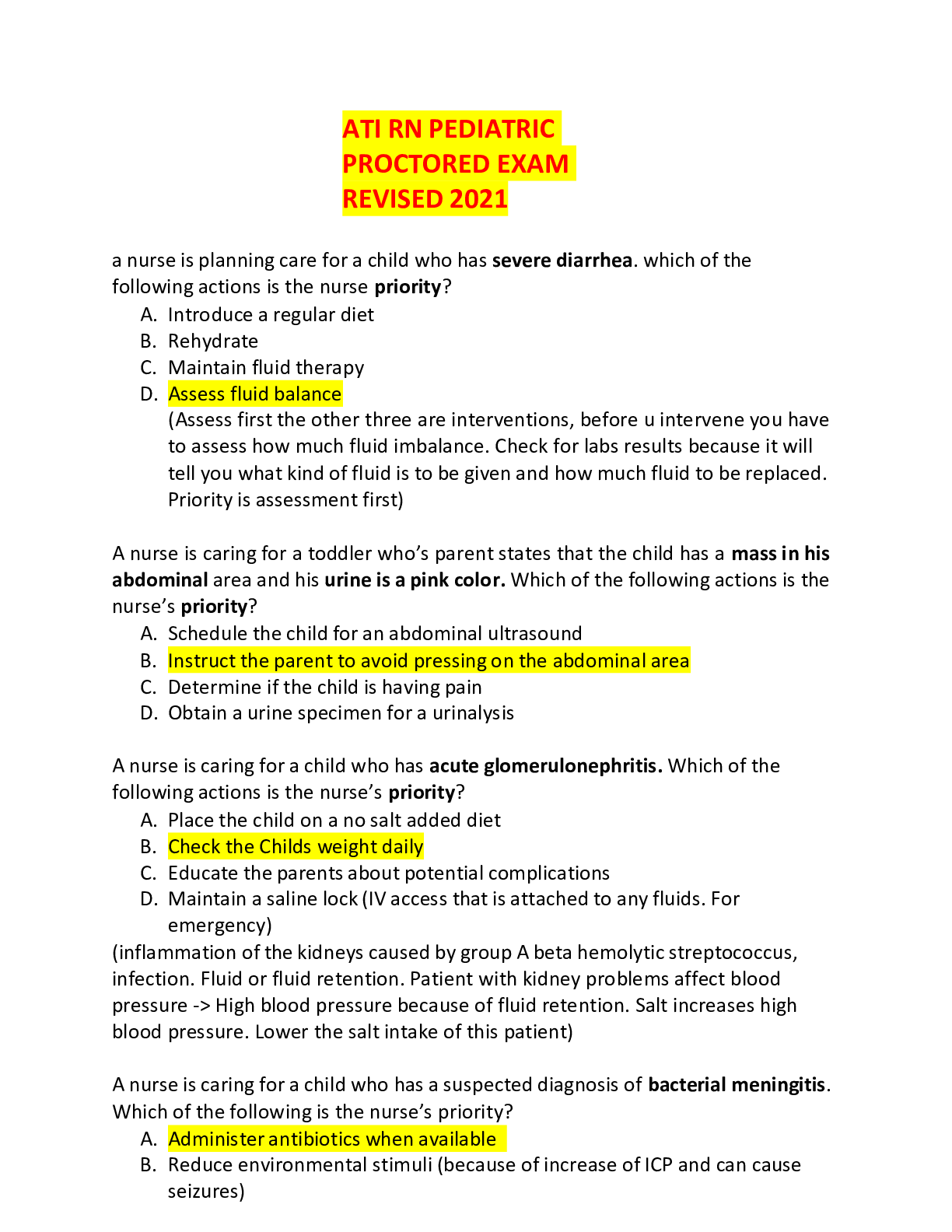
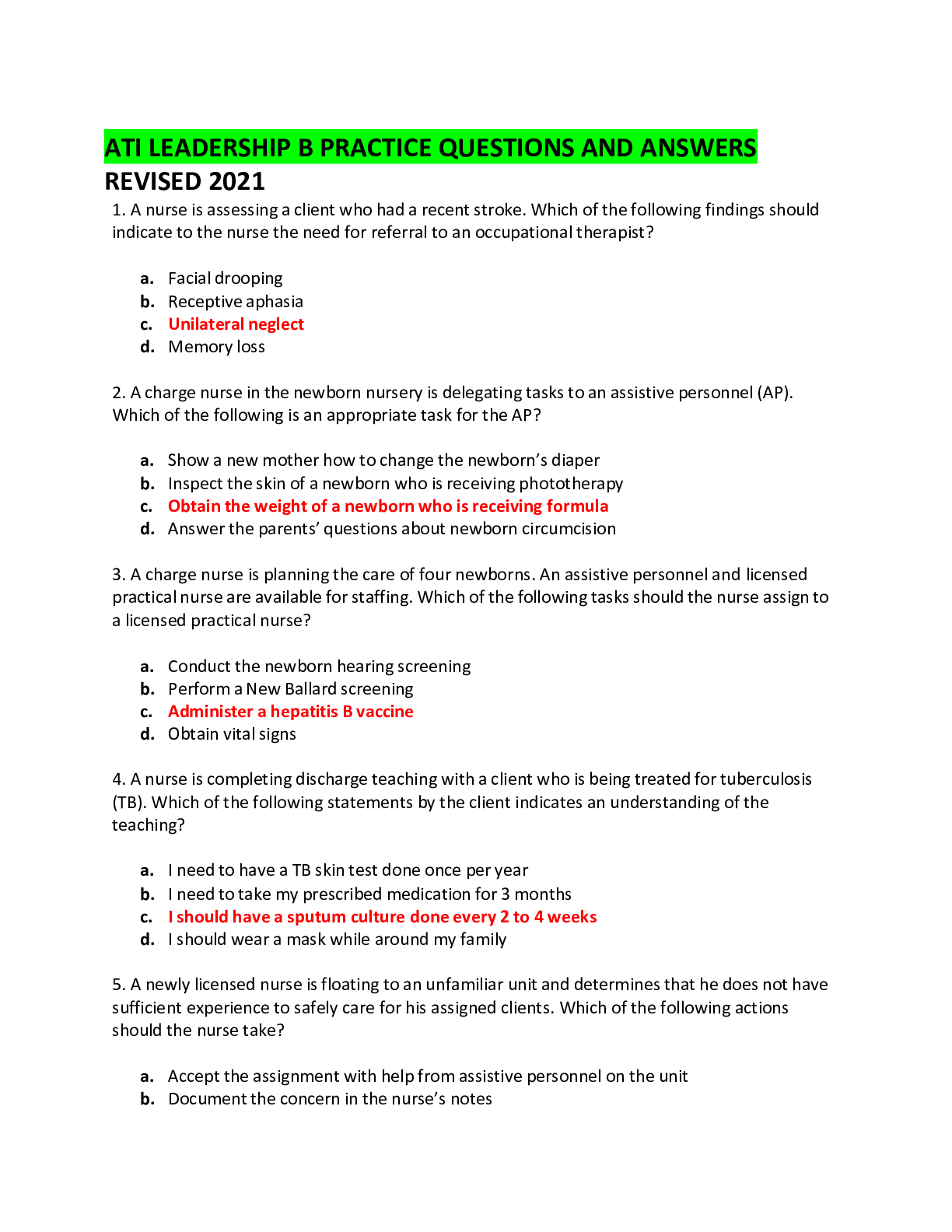


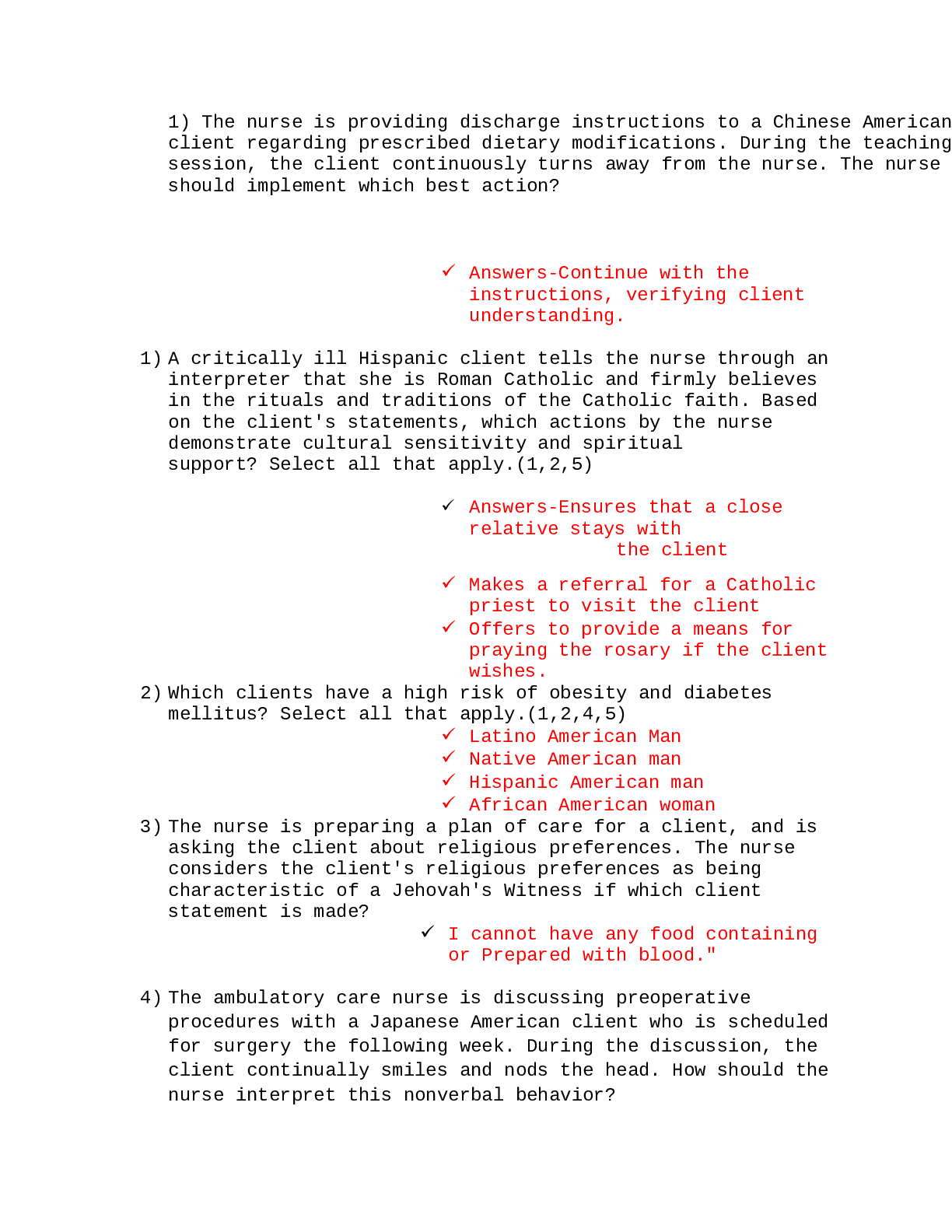
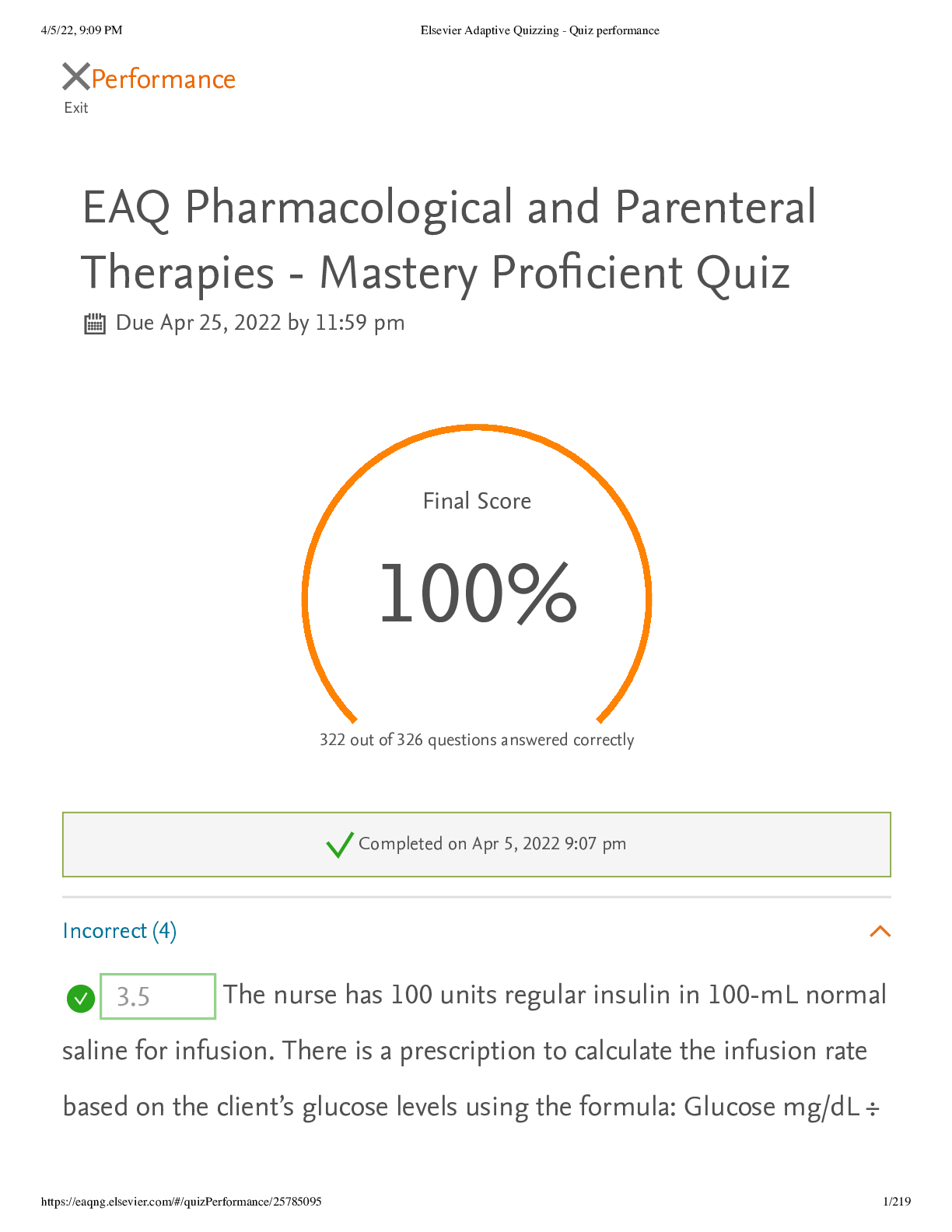
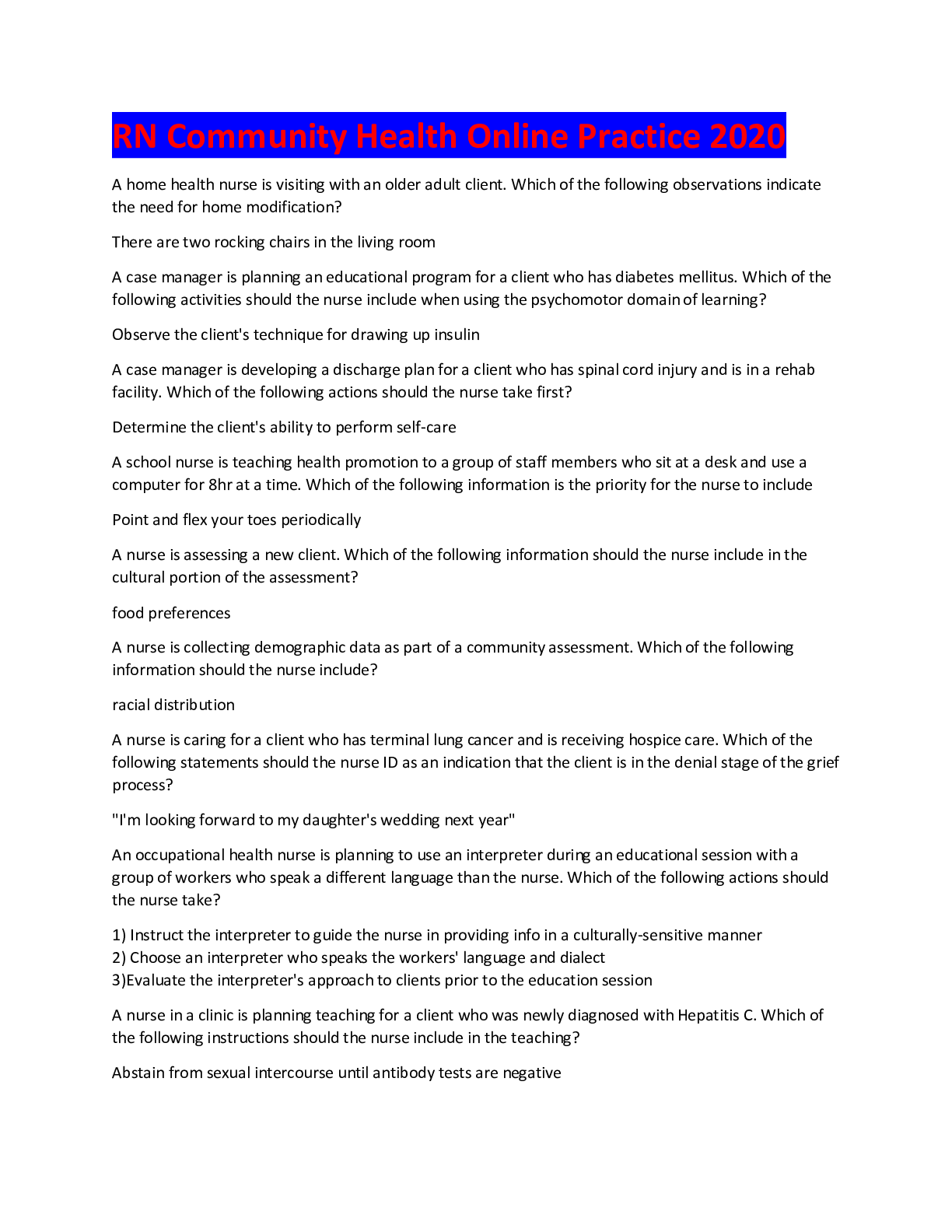
.png)
